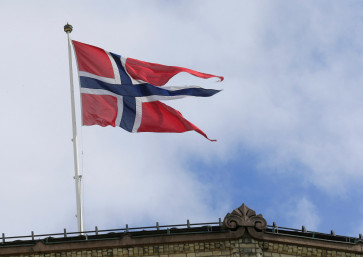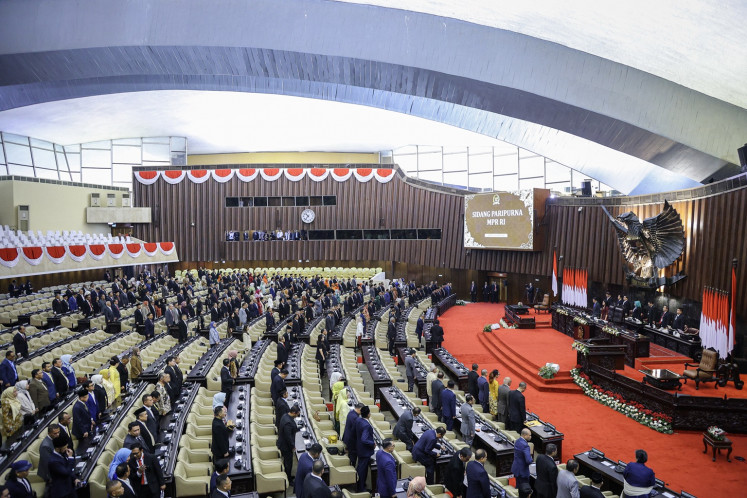Popular Reads
Top Results
Can't find what you're looking for?
View all search resultsPopular Reads
Top Results
Can't find what you're looking for?
View all search results‘Merdeka Sejak Hati’: A Tribute to Lafran Pane
Discussing a legend: Moderator Frisca Clarissa (left), writer A
Change text size
Gift Premium Articles
to Anyone
D
iscussing a legend: Moderator Frisca Clarissa (left), writer A. Fuadi (second left), Lafran Pane's nephew Nina Pane (center), politician Akhmad Muqowam (second right) and researcher Hariqo Wibawa talk about Fuadi's new book, Merdeka Sejak Hati, in a discussion at the National Library in Jakarta. (Photo by A. Kurniawan Ulung)
Even though the Association of Islamic Students (HMI) is the biggest student organization in Indonesia, nobody has ever truly dug deep into the story of its founder Lafran Pane. That is, until now.
Award-winning author Ahmad Fuadi has chronicled the life of Lafran, who went from zero to hero, in a new book titled Merdeka Sejak Hati (Independence Starts from the Heart).
Lafran may not be as well-known as his older brothers, acclaimed poet Sanusi Pane and renowned novelist Armijn Pane, yet he is arguably one of the most influential academics in Indonesian history thanks to the HMI, which he founded in 1947 in Yogyakarta.
Standing on the front line of promoting a tolerant Islam and safeguarding the state ideology, Pancasila, and national motto Bhinneka Tunggal Ika (Unity in Diversity), the HMI has a reputation as a training ground for Muslim intellectuals and leaders, such as the late Nurcholish “Cak Nur” Madjid, former Constitutional Court chief Mahfud MD and Vice President Jusuf Kalla.
When celebrating National Heroes Day at the State Palace in 2017, President Joko “Jokowi” Widodo declared Lafran a national hero — 26 years after he passed away at the age of 68 in an accident in 1991.
Merdeka Sejak Hati also tells stories about Lafran that most people outside of HMI circles have yet to hear.
For example, many might not know that Lafran had behavioral and anger issues before becoming a respected scholar and eventually professor at Sunan Kalijaga State Islamic University. From the beginning of his life, he faced hardship and had to do whatever it took to make ends meet.
Courtesy of Goodreads.comThe novel begins with the most heart-wrenching part of his childhood: the passing of his mother, Gonto Siregar.
When expecting Lafran, Gonto was in mourning over the death of her daughter, Siti Zahara. Her health declined sharply then as her husband, Sutan Pangurabaan, was not by her side. He worked out of town, making a living as a teacher.
After giving birth to Lafran in February 1922 in Padang Sidempuan, North Sumatra, her health further deteriorated. Her stress from this caused vision loss. Throughout all this, she suffered a broken heart when Sutan got married to another woman without her knowledge. Not long after that, she died, with Lafran only at 2 years of age. Thereafter, he was raised by his grandmother.
Feeling unloved by Sutan, Lafran grew up to be a troublemaker. He not only liked to skip class but also often fought with his friends and came home late. He spent most of his time on the street before dropping out of school. Sitiangat, Lafran’s oldest sister who took care of him after their grandmother died, gave up on him.
Tired of rules and norms, he ran away from home to get the freedom that he wanted. He decided to become a boxer at a night market in Medan to make money. As it turned out, he was good at fighting. His fans even called him Si Beliung (The Tornado) because of his fast-paced boxing style.
Lafran traveled to Batavia, where he met his famous brothers, Armijn and Sanusi. They enrolled him at MULO Muhammadiyah. However, he became even more rebellious and, at one point, was involved in borderline criminal activity with street gangs.
Things began to change for Lafran when he met a teacher named Suryo, who taught at Ki Hajar Dewantara’s Taman Siswa school.
Suryo helped Lafran to have a better understanding of life. At Taman Siswa, Lafran also got involved in activism for the first time.
Ahmad Fuadi (Photo by A. Kurniawan Ulung)He actively took part in discussions about social and political movements for a better Indonesia with big names as invited speakers, including Sutan Sjahrir, Mohammad Hatta and Sukarno.
As a result, Lafran no longer hated school. Thanks to Suryo and the activism at Taman Siswa, Lafran found just the perfect way to channel his youthful energy into something more positive and productive.
After graduating from Taman Siswa, he continued his education on his own initiative at Islamic Higher School, now the Islamic University of Indonesia, in Yogyakarta. It was there that he founded the HMI in a classroom on Feb. 5, 1947.
Merdeka Sejak Hati suggests that the absence of a mother had a significant impact on the development of Lafran. The lack of a maternal figure is perhaps what drove Lafran’s negative feelings, poor behavior and problems with social relationships.
They were part of his journey of discovering his true identity and upholding his self-worth. He made mistakes, but they shaped him. He was not embarrassed by his failures. He learned from them and moved forward.
Lafran was fearless, but for Ahmad, what inspired him the most as a writer was Lafran’s honesty and simple life. Coming from a well-to-do family with renowned relatives did not make him arrogant or overweening.
Ahmad said he was honored to be trusted to write a novel about Lafran’s life even though he was not a member of the HMI. To write Merdeka Sejak Hati, he researched the organization’s documents and interviewed various people, including Lafran’s family members and friends.
“This novel is about Lafran’s heart. Deep down in his heart, he felt a longing for his mother. He also longed for independence. First, he wanted to be independent of rules made by other people. He later thought about independence for all, independence for Indonesia,” Fuadi said. (hdt)
_____________
‘Merdeka Sejak Hati’
by Ahmad Fuadi
Paperback, 380 pages
Published May 26, 2019 by Gramedia Pustaka Utama
ISBN13
9786020622965
Edition Language Indonesian












